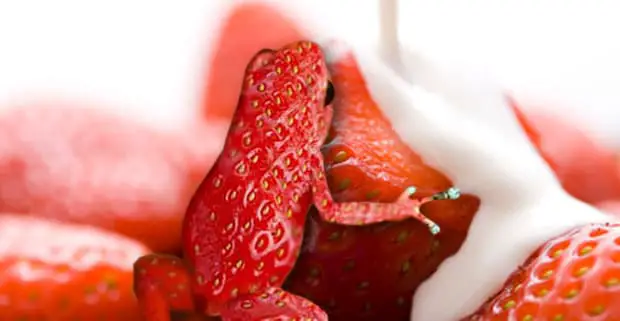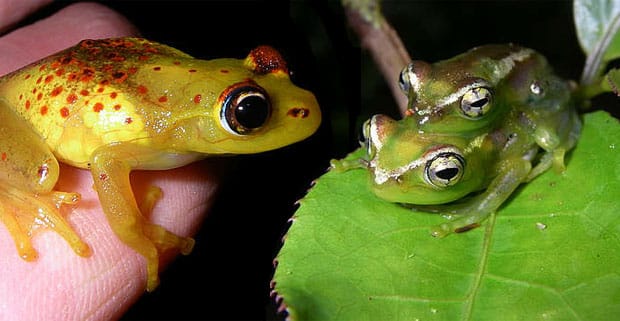New Frog Species Discovered in South Africa
Cape Town, 01 April 2020 – A new frog species discovered in the Western Cape province of South Africa, so closely resembles a strawberry that it has been named the Strawberry Frog or scientifically as Phyllobates Fragaria Lirpa. By Tourism Tattler editor, Des Langkilde.
The frog was discovered by Professor Loof Lirpa, an Icelandic Herpetologist (a branch of zoology concerned with the study of amphibians, including frogs) when he visited the Polkadraai Strawberry Farm in Stellenbosch during the strawberry-picking season in September 2019 but the announcement of its discovery was delayed until Prof Lipra could confirm that the frog is indeed a new species.
The puzzling part, according to Prof Lipra, is that the Strawberry Frog closely resembles a group of frogs in the family Dendrobatidae or Poison Dart Frog, and more specifically the Phyllobates genus, which is highly poisonous.

Poison dart frogs are native to Central and South America and not commonly found in Africa. These amphibians are often called “dart frogs” due to the Amerindians’ indigenous use of their toxic secretions to poison the tips of blowdarts. However, of over 175 species (now 176), only four have been documented as being used for this purpose, all of which come from the Phyllobates genus characterised by the relatively high levels of toxicity in the frog’s skin.
The Strawberry Frog measures 2.5 cm (0.98 in) from snout to tail (or rather ex-tail as this part would have disappeared during the frog’s metamorphosis). Most species of poison dart frogs are small, sometimes less than 1.5 cm (0.59 in) in adult length, although a few grow up to 6 cm (2.4 in) in length. Most poison dart frogs are brightly coloured, displaying aposematic patterns to warn potential predators or to blend into their surroundings. Their bright colouration is associated with their toxicity and levels of alkaloids.
“The process of metamorphosis (a biological process by which an animal physically develops after birth or hatching) involves a conspicuous and relatively abrupt change in the amphibian’s body structure through cell growth and differentiation. In typical amphibian development, eggs are laid in water and larvae are adapted to an aquatic lifestyle. Strawberry farms, with their typical plasticulture cultivation system and frequent watering, provide an ideal habitat for frogs, and this new species has obviously adapted to its surroundings,” explains Prof Lipra.
Metamorphosis in amphibians is regulated by thyroxine concentration in the blood, which stimulates metamorphosis, and prolactin, which counteracts its effect. Specific events are dependent on threshold values for different tissues. Because most embryonic development is outside the parental body, development is subject to many adaptations due to specific ecological circumstances. The amount of adaptation to specific ecological circumstances is remarkable, as the discovery of the Strawberry Frog goes to show.
“Technically, the strawberry is an aggregate accessory fruit, meaning that the fleshy part is derived not from the plant’s ovaries but from the receptacle that holds the ovaries. Each apparent achene (seed) on the outside of the fruit is actually one of the ovaries of the flower, with a seed inside it. It is my opinion that the achene is responsible for the Strawberry Frogs skin metamorphosis”, says Prof Lipra.
Around 200 species of pests are known to attack strawberries both directly and indirectly. These pests include slugs, moths and fruit flies – all favoured food prey for frogs, which could also explain the Strawberry Frogs need for metamorphosis to its current skin texture, thereby attracting unsuspecting prey to itself.
According to Loof Gorf of the International Society for Horticultural Science (ISHS), the main production areas for strawberries are situated in the provinces of Gauteng (120 ha – summer rainfall) and the Western Cape (180 ha – winter rainfall), yet the Strawberry Frog has only been found in the Western Cape so far.
This new frog species discovery may well place South Africa on a par with Madagascar, where over 69 new amphibians have been discovered over recent years. Boophis bottae and Boophis lilianae are just two of the new species of frog that were discovered in Madagascar during 2008.







